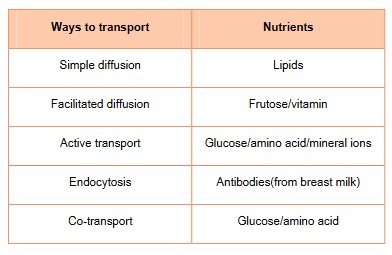Topic 6: Human physiology
6.1 Digestion and absorption
Digestive track
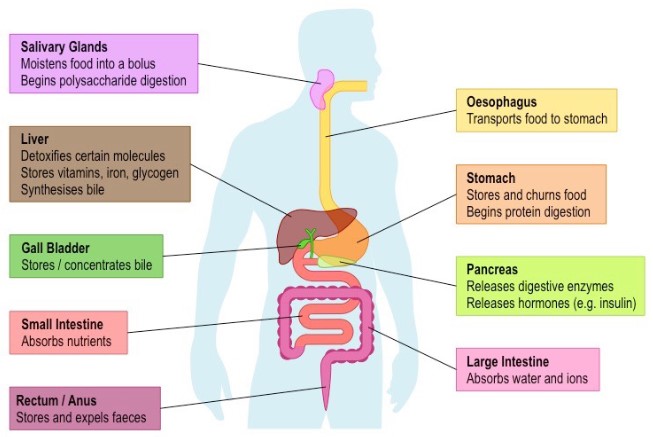
Mouth
- Chewing, physical digestion of the food
- Saliva moistens the food, produce a ball of food called bolus
- Saliva amylase begins chemical digestion of starch to maltose
Oesophagus
- A wave of muscle contraction to push the bolus to stomach; such movement of muscle called peristalsis
- Peristalsis also occurs in small intestine
Stomach
- Muscle contraction continues mechanical digestion
- Produce hydrochloric acid to kill bacteria and aid digestion
- Produce pepsin to break down protein
- Have thick layers of mucus to stop HCl from breaking down itself
- The end product is called chyme, which flows into duodenum
Duodenum
- Beginning part of small intestine
- Bile from liver and gallbladder neutralize acid and emulsifies fat
- Pancreatic amylase to digest carbohydrates
- Lipase to digest fat
- Trypsin to digest protein
ileun:
- Lower half of small intestine
- Absorb nutrients into the blood via villi
Large intestine
- Water re-absorption
- Leaving semi-solid feces and store in the rectum
Peristalsis
- The contraction of circular and longitudinal muscle of the small intestine helps mix (mechanical digestion) the food with enzymes and moves the semi-digested food (bolus) along the gut in a process called peristalsis
- These muscles are made up of smooth muscle
- Contraction of longitude muscle expands the lumen in front of the food, giving it space to move into.
- Contraction of circular muscle behind the food propels it forward.
- Food is transported slowly through the small intestine to allow for maximum digestion and absorption of nutrients
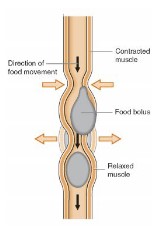
Enzymes in digestion
- Enzymes are biological catalysts that speed up the rate of reaction in chemical digestion.
- Enzymes in digestion catalyze hydrolysis reactions.
- Pancreatic juice secreted into small intestine contains enzymes such as:
- Peptidases – example trypsin (breaks apart the peptide bond between amino acids in polypeptides)
- Trypsin works in duodenum and pepsin works in stomach due to their different range.
- Lipases – catalyzes the hydrolysis of lipids (triglycerides and phospholipids)
- Amylases – digestion of starch.
- Pancreatic juice is alkaline (basic) to allow enzymes to work at an optimal pH (around 7-8 in the small intestine).
- Bile is produced in liver and stored in gallbladder, which is used to neutralize the stomach acid and emulsify the fat (breaking down fat into smaller droplets.).
- Please note that some carbohydrates such as cellulose cannot be digested by humans as we lack the enzymes needed to break down cellulose
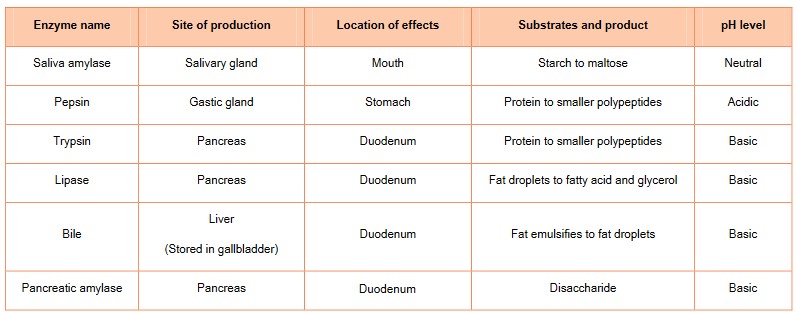
Small intestine structure
- Serosa layer – protective outer layer
- Muscular layer – inner circular and outer longitudinal muscle (smooth muscle) which performs peristalsis
- Submucosa layer – connective tissue between mucosa and muscular layer
- Mucosa – inner lining, includes villi for absorption
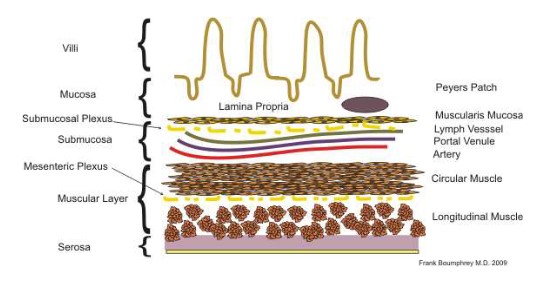
Villi
- Villi are finger-like projections that make the surface of the small intestine look highly folded. These projections increase the surface area (by about 10X) available for absorption (the process of taking substances into the cells and blood).
- The outermost layer of the villi is thin epithelial cells to allow nutrients to easily move across a short distance into the blood.
- Microvilli on the surface of each epithelial cells are small hair-like projections attached to the villi to further increase surface area.
- A dense network of blood capillaries close to the epithelium allows a shorter diffusion pathway.
- Lacteals, which are a part of the lymphatic system, run up the middle of the villi. The lacteal allows for the absorption of the products of lipid digestion which are not easily absorbed by the capillaries.
- Rich blood supply maintains a concentration gradient between lumen and blood
Absorption of villi
- Digestion – process which breaks down larger food molecules to smaller molecules.
- Absorption – process where small molecules and nutrients pass into the blood vessels (capillary beds) in the wall of the intestine.
- Assimilation – products of digestion that are absorbed into the blood are transported to the various tissues. These molecules are used to build up larger molecules that become part of the structure of the tissue or body.
- These products include the following monomers:
- Monosaccharides
- Amino acids from the breakdown of proteins
- Nitrogenous bases from the breakdown of nucleotides
- Glycerol and fatty acids, which are the products of lipids are absorbed by the lacteal inside the villi.
- Mineral ions such as sodium, potassium and calcium, and vitamins such as vitamin C, are also absorbed by the villi in the small intestine
